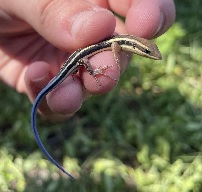African Five-Lined Skink (Trachylepis quinquetaeniata)
Classification: Introduced Species It is not evident how competition from this introduced species impacts native species, but the spread of this or any non-native species should be discouraged. It's likely that this species will compete with native lizard species for resources, most likely Sceloporus occidentalis and Elgaria multicarinata.
Description: Trachylepis quinquetaeniata is a medium-sized lizard reaching a length of about 7.9 inches. The coloration of this species is quite variable, depending on the gender and the age. The scales are glossy, with metallic reflections. The basic colour is usually olive-brown or dark brown, sometimes with pearly whitish spots and with three light olive or dark brown stripes running from the head to the electric blue tail. These stripes may fade and become indistinct in the adults.
The head shows a pointed snout and clearly visible ears holes. Just behind the ear opening, there are some black spots. Legs are dark brown, short and strong, with relatively long toes. The flanks are mainly yellowish and the underside of the body is whitish.
Habitat: These skinks are found in both rocky and grassland habitats. They tend to make their homes on trees, but also can be found using manmade structures for this purpose.
Range: The species is found in Egypt and southern Africa It has been found across the African continent and is also an invasive species in Florida. It has been introduced and is established in Port St. Lucie, St. Lucie County, Florida
Range in California: Originally discovered in Glendora in the San Gabriel Valley in eastern Lost Angeles County. As of January 2022 there are several records on iNatualist dating from 2016-2020 that are shown on the map as Baldwin Park, Azusa, Glendora, and City of Industry and elsewhere, but since the actual locations of the records have been obscured, the locations shown on the map are not accurate.
Found in these States:
CA |
FL
Diet: This species' diet consists of mostly insects, particularly beetles, butterflies, and ants, with little to no variation between the diet of males and females.
Reproduction: The species is oviparous. The female lays 6-10 eggs in summer. The young hatch after 61-62 days. Females may lay two clutches per season. (Siyabona Africa) Females may guard the eggs.
Status: Listed as Least Concern in view of its wide distribution, tolerance of a high degree of habitat modification, presumed large population, and the absence of major threats.
»» Kingdom: Animalia - Animals
»» Phylum: Chordata - Chordates
»» Subphylum: Vertebrata - Vertebrates
»» Class: Reptilia - Reptiles
»» Order: Squamata - Lizards
»» Family: Scincidae - Skinks
»» Genus: Trachylepis
»» Species: Trachylepis quinquetaeniata - African Five-Lined Skink
»» Subspecies: None
This article uses material from the Wikipedia article "Trachylepis quinquetaeniata", which is released under the Creative Commons Attribution-Share-Alike License 3.0. Content may have been omitted from the original, but no content has been changed or extended.
|








